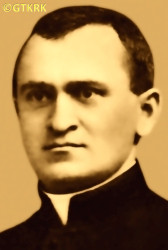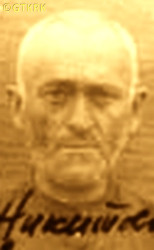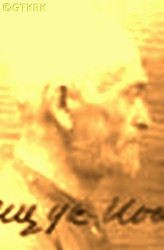Roman Catholic
St Sigismund parish
05-507 Słomczyn
85 Wiślana Str.
Konstancin deanery
Warsaw archdiocese, Poland
full list:
displayClick to display full list

searchClick to search full list by categories
wyświetlKliknij by wyświetlić pełną listę po polsku

szukajKliknij by przeszukać listę wg kategorii po polsku

Martyrology of the clergy — Poland
XX century (1914 – 1989)
personal data
surname
LESZCZUK
forename(s)
Joseph (pl. Józef)

function
eparchial priest
creed
Ukrainian Greek Catholic GCmore on
en.wikipedia.org
[access: 2013.05.19]
diocese / province
Przemyśl GC eparchymore on
pl.wikipedia.org
[access: 2013.05.19]
honorary titles
canonmore on
en.wikipedia.org
[access: 2014.11.14]
nationality
Ukrainian
date and place
of death
28.08.1949

Bozhkovotoday: Poltava obl., Ukraine
details of death
Prob. participant of Polish–Ukrainian war of 1918‐1919 as a soldier of the Ukrainian Galician Army UHA (fighting mainly in Hungary).
In 1923, during the first famine in Russian Ukraine, as the head of the local branch of the „Enlightenment” organization, initiated a protest against the deliberate destruction of the Ukrainian nation by Soviet Russia.
After the end of military hostitilies of the World War II, started by German and Russian invasion of Poland in 09.1939 — after German defeat and start in 1944 of another Russian occupation — active opponent of a group preparing incorporation of the Greek Catholic Church into Russian Orthodoxy (known as „initiative group” that finally managed to bring a formal dissolution of Greek Catholic Church by the Russians and its incorporation into Russian Orthodox Church on 08‐10.03.1946 during so‐called Lviv pseudo–council).
This opposition led to his arrest on 11.10.1945 by the agents of Russian genocidal NKVD organisation from Lviv oblast.
Accused of among others that „while living in Rava–Ruska […] publish two books in 1937 [i.e. «Christian education of the youth» and «Teaching the candidates to Marys' Teams»] nationalist in nature, slandering the Soviet Russian state, the Communist party and life in Soviet Russia. And in 10.1945 during the search of his premises two anti–Russian and nationalistic book, printed in 1942 and 1942, were found”.
On 18.04.1943 sentenced by the kangaroo court of murderous MGB organisation (successor of NKVD) from Lviv oblast to 10 years of slave labour in Russian concentration camps Gulag.
Transported to Stalino concentration camp, to Yasynuvata village, and next to country „resocialisation colony” No. 16 in Bozhkovo village.
There perished.
cause of death
extermination
perpetrators
Russians
sites and events
KLW StalinoClick to display the description, GulagClick to display the description, Ribbentrop‐MolotovClick to display the description, Pius XI's encyclicalsClick to display the description, Polish‐Ukrainian war of 1918‐1919Click to display the description
date and place
of birth
06.01.1894

Staivkatoday: Belz urban hrom., Sheptytskyi rai., Lviv obl., Ukraine
more on
uk.wikipedia.org
[access: 2023.03.02]
alt. dates and places
of birth
18.01.1894
parents
LESZCZUK Nicetas
🞲 1863, ? — 🕆 1920, ?

ZABOROCIUK Mary
🞲 1867, ? — 🕆 1911, ?
presbyter (holy orders)
ordination
10.04.1921

Przemyśltoday: Przemyśl city pov., Subcarpathia voiv., Poland
more on
en.wikipedia.org
[access: 2021.04.01]
St Therese GC cathedral churchmore on
en.wikipedia.org
[access: 2025.03.14]
positions held
1944 – 1945
priest — Rava‐Ruskatoday: Rava‐Ruska urban hrom., Lviv rai., Lviv obl., Ukraine
more on
en.wikipedia.org
[access: 2022.01.16] ⋄ St George the Martyr GC parish ⋄ Rava‐Ruskatoday: Rava‐Ruska urban hrom., Lviv rai., Lviv obl., Ukraine
more on
en.wikipedia.org
[access: 2022.01.16] GC deanery
1941 – 1944
prefect — Rava‐Ruskatoday: Rava‐Ruska urban hrom., Lviv rai., Lviv obl., Ukraine
more on
en.wikipedia.org
[access: 2022.01.16] ⋄ primary schools ⋄ St George the Martyr GC parish ⋄ Rava‐Ruskatoday: Rava‐Ruska urban hrom., Lviv rai., Lviv obl., Ukraine
more on
en.wikipedia.org
[access: 2022.01.16] GC deanery
1939 – 1941
administrator — Rava‐Ruskatoday: Rava‐Ruska urban hrom., Lviv rai., Lviv obl., Ukraine
more on
en.wikipedia.org
[access: 2022.01.16] ⋄ St George the Martyr GC parish ⋄ Rava‐Ruskatoday: Rava‐Ruska urban hrom., Lviv rai., Lviv obl., Ukraine
more on
en.wikipedia.org
[access: 2022.01.16] GC deanery
head/manager — „Mary's Team” — also: founder
1939 – 1941
administrator — Staivkatoday: Belz urban hrom., Sheptytskyi rai., Lviv obl., Ukraine
more on
uk.wikipedia.org
[access: 2023.03.02] ⋄ St Michael the Archangel GC parish ⋄ Uhnivtoday: Belz urban hrom., Sheptytskyi rai., Lviv obl., Ukraine
more on
en.wikipedia.org
[access: 2020.11.24] GC deanery
till 1939
priest — Richkytoday: Rava‐Ruska urban hrom., Lviv rai., Lviv obl., Ukraine
more on
uk.wikipedia.org
[access: 2023.03.02] ⋄ Assumption of the Blessed Virgin Mary GC parish ⋄ Rava‐Ruskatoday: Rava‐Ruska urban hrom., Lviv rai., Lviv obl., Ukraine
more on
en.wikipedia.org
[access: 2022.01.16] GC deanery — commuting on Sundays and Days of Obligation
1921 – 1939
prefect — Rava‐Ruskatoday: Rava‐Ruska urban hrom., Lviv rai., Lviv obl., Ukraine
more on
en.wikipedia.org
[access: 2022.01.16] ⋄ schools, incl. a lycem ⋄ St George the Martyr GC parish ⋄ Rava‐Ruskatoday: Rava‐Ruska urban hrom., Lviv rai., Lviv obl., Ukraine
more on
en.wikipedia.org
[access: 2022.01.16] GC deanery
c. 1919 – c. 1920
soldier — Ukrainian Galician Army UHA
1917 – 1918
student — Przemyśltoday: Przemyśl city pov., Subcarpathia voiv., Poland
more on
en.wikipedia.org
[access: 2021.04.01] ⋄ philosophy and theology, Greek Catholic Theological Seminary
1915 – 1916
student — Lvivtoday: Lviv urban hrom., Lviv rai., Lviv obl., Ukraine
more on
en.wikipedia.org
[access: 2022.01.16] ⋄ philosophy and theology, Greek Catholic Theological Seminary
1914 – 1915
student — Kroměřížtoday: Kroměříž dist., Zlín reg., Czechia
more on
en.wikipedia.org
[access: 2022.01.22] ⋄ philosophy and theology, Theological Seminary
student — Viennatoday: Vienna state, Austria
more on
en.wikipedia.org
[access: 2020.07.31] ⋄ philosophy and theology, Greek Catholic Theological Seminary
writer and editor
widower — four children
sites and events
descriptions
KLW Stalino: Russian Rus. Концентрационные Лагеря для Военнопленных (Eng. POW Concentration Camps) KLW, managed by the genocidal Russian organization NKVD — and in practice by its Rus. Главное управление по делам военнопленных и интернированных (Eng. General Directorate for Prisoners of War and Internees) GUPWI — founded starting from 1942‐1943, in Stalino (now Donetsk), centre of Donbas coal mining and steel making region in Rus. Южный регион (Eng. Southern Region), in Ukraine. Prisoners of these camps — there were 34 of them in the entire region with 515 sub‐camps — slaved in many industrial plants in the region. In 1944‐1946 the Rus. Проверочно‐Фильтрационный Ла́герь (Eng. Testing and Filtration Camp) PFL No. 240 „Petrovskiy” was set up and at the beginning of 1945 had c. sub camps, including in Yenakiyeve, and number of prisoners reached 31,336 (04.1945) and 35,135 (08.1945). POW camp No. 280, known also as „Rutchenkovskiy”, was operational longer. Russians brought there internees from the regions captured by their army who had not managed to escape with withdrawing Germans, among others from Warmia. Most slaved in Donbas coal mines. E.g. on 03.07.1945 Russians held there 49,150 POWs, among whom were c. 4,782 soldiers of Polish Home Army AK and other independent resistance organizations (part of Polish Clandestine State). In 04‐05.1945 Russians sent tens of thousands of miners from Silesia to slave labour in Donbas mines — only some returned to Poland, 10 years later. (more on: pl.wikipedia.orgClick to attempt to display webpage
[access: 2018.09.02])
Gulag: The acronym Gulag comes from the Rus. Главное управление исправительно‐трудовых лагерей и колоний (Eng. Main Board of Correctional Labor Camps). The network of Russian concentration camps for slave labor was formally established by the decision of the highest Russian authorities on 27.06.1929. Control was taken over by the OGPU, the predecessor of the genocidal NKVD (from 1934) and the MGB (from 1946). Individual gulags (camps) were often established in remote, sparsely populated areas, where industrial or transport facilities important for the Russian state were built. They were modeled on the first „great construction of communism”, the White Sea‐Baltic Canal (1931‐1932), and Naftali Frenkel, of Jewish origin, is considered the creator of the system of using forced slave labor within the Gulag. He went down in history as the author of the principle „We have to squeeze everything out of the prisoner in the first three months — then nothing is there for us”. He was to be the creator, according to Alexander Solzhenitsyn, of the so‐called „Boiler system”, i.e. the dependence of food rations on working out a certain percentage of the norm. The term ZEK — prisoner — i.e. Rus. заключенный‐каналоармец (Eng. canal soldier) — was coined in the ITL BelBaltLag managed by him, and was adopted to mean a prisoner in Russian slave labor camps. Up to 12 mln prisoners were held in Gulag camps at one time, i.e. c. 5% of Russia's population. In his book „The Gulag Archipelago”, Solzhenitsyn estimated that c. 60 mln people were killed in the Gulag until 1956. Formally dissolved on 20.01.1960. (more on: en.wikipedia.orgClick to attempt to display webpage
[access: 2024.04.08])
Ribbentrop‐Molotov: Genocidal Russian‐German alliance pact between Russian leader Joseph Stalin and German leader Adolf Hitler signed on 23.08.1939 in Moscow by respective foreign ministers, Mr. Vyacheslav Molotov for Russia and Joachim von Ribbentrop for Germany. The pact sanctioned and was the direct cause of joint Russian and German invasion of Poland and the outbreak of the World War II in 09.1939. In a political sense, the pact was an attempt to restore the status quo ante before 1914, with one exception, namely the „commercial” exchange of the so‐called „Kingdom of Poland”, which in 1914 was part of the Russian Empire, fore Eastern Galicia (today's western Ukraine), in 1914 belonging to the Austro‐Hungarian Empire. Galicia, including Lviv, was to be taken over by the Russians, the „Kingdom of Poland” — under the name of the General Governorate — Germany. The resultant „war was one of the greatest calamities and dramas of humanity in history, for two atheistic and anti‐Christian ideologies — national and international socialism — rejected God and His fifth Decalogue commandment: Thou shall not kill!” (Abp Stanislav Gądecki, 01.09.2019). The decisions taken — backed up by the betrayal of the formal allies of Poland, France and Germany, which on 12.09.1939, at a joint conference in Abbeville, decided not to provide aid to attacked Poland and not to take military action against Germany (a clear breach of treaty obligations with Poland) — were on 28.09.1939 slightly altered and made more precise when a treaty on „German‐Russian boundaries and friendship” was agreed by the same murderous signatories. One of its findings was establishment of spheres of influence in Central and Eastern Europe and in consequence IV partition of Poland. In one of its secret annexes agreed, that: „the Signatories will not tolerate on its respective territories any Polish propaganda that affects the territory of the other Side. On their respective territories they will suppress all such propaganda and inform each other of the measures taken to accomplish it”. The agreements resulted in a series of meeting between two genocidal organization representing both sides — German Gestapo and Russian NKVD when coordination of efforts to exterminate Polish intelligentsia and Polish leading classes (in Germany called «Intelligenzaktion», in Russia took the form of Katyń massacres) where discussed. Resulted in deaths of hundreds of thousands of Polish intelligentsia, including thousands of priests presented here, and tens of millions of ordinary people,. The results of this Russian‐German pact lasted till 1989 and are still in evidence even today. (more on: en.wikipedia.orgClick to attempt to display webpage
[access: 2015.09.30])
Pius XI's encyclicals: Facing the creation of two totalitarian systems in Europe, which seemed to compete with each other, though there were more similarities than contradictions between them, Pope Pius XI issued in 03.1937 (within 5 days) two encyclicals. In the „Mit brennender Sorge” (Eng. „With Burning Concern”) published on 14.03.1938, condemned the national socialism prevailing in Germany. The Pope wrote: „Whoever, following the old Germanic‐pre‐Christian beliefs, puts various impersonal fate in the place of a personal God, denies the wisdom of God and Providence […], whoever exalts earthly values: race or nation, or state, or state system, representatives of state power or other fundamental values of human society, […] and makes them the highest standard of all values, including religious ones, and idolizes them, this one […] is far from true faith in God and from a worldview corresponding to such faith”. On 19.03.1937, published „Divini Redemptoris” (Eng. „Divine Redeemer”), in which criticized Russian communism, dialectical materialism and the class struggle theory. The Pope wrote: „Communism deprives man of freedom, and therefore the spiritual basis of all life norms. It deprives the human person of all his dignity and any moral support with which he could resist the onslaught of blind passions […] This is the new gospel that Bolshevik and godless communism preaches as a message of salvation and redemption of humanity”… Pius XI demanded that the established human law be subjected to the natural law of God , recommended the implementation of the ideal of a Christian state and society, and called on Catholics to resist. Two years later, National Socialist Germany and Communist Russia came together and started World War II. (more on: www.vatican.vaClick to attempt to display webpage
[access: 2023.05.28], www.vatican.vaClick to attempt to display webpage
[access: 2023.05.28])
Polish‐Ukrainian war of 1918‐1919: One of the wars for borders of the newly reborn Poland. At the end of 1918 on the former Austro‐Hungarian empire’s territory, based on the Ukrainian military units of the former Austro‐Hungarian army, Ukrainians waged war against Poland. In particular attempted to create foundation of an independent state and attacked Lviv. Thanks to heroic stance of Lviv inhabitants, in particular young generation of Poles — called since then Lviv eaglets — the city was recaptured by Poles and for a number of months successfully defended against furious Ukrainian attacks. In 1919 Poland — its newly created army — pushed Ukrainian forces far to the east and south, regaining control over its territory. (more on: en.wikipedia.orgClick to attempt to display webpage
[access: 2017.05.20])
sources
personal:
uk.wikipedia.orgClick to attempt to display webpage
[access: 2020.04.04], postup.brama.comClick to attempt to display webpage
[access: 2020.04.04]
bibliographical:
„Clergy of Przemyśl Eparchy and Apostolic Exarchate of Lemkivshchyna”, Bogdan Prach, Ukrainian Catholic University Publishing House, Lviv 2015
original images:
uk.wikipedia.orgClick to attempt to display webpage
[access: 2020.04.04], web.archive.orgClick to attempt to display webpage
[access: 2020.04.04], web.archive.orgClick to attempt to display webpage
[access: 2020.04.04]
LETTER to CUSTODIAN/ADMINISTRATOR
If you have an Email client on your communicator/computer — such as Mozilla Thunderbird, Windows Mail or Microsoft Outlook, described at WikipediaPatrz:
en.wikipedia.org, among others — try the link below, please:
LETTER to CUSTODIAN/ADMINISTRATORClick and try to call your own Email client
If however you do not run such a client or the above link is not active please send an email to the Custodian/Administrator using your account — in your customary email/correspondence engine — at the following address:

giving the following as the subject:
MARTYROLOGY: LESZCZUK Joseph
To return to the biography press below:
 Click to return to biography
Click to return to biography










